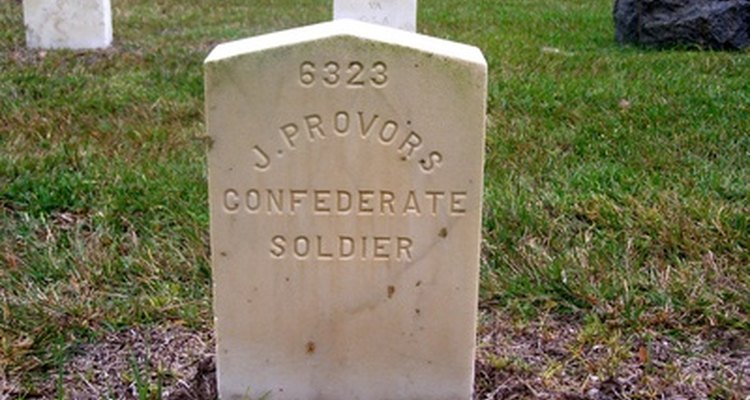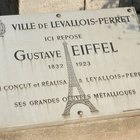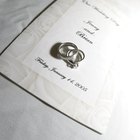
Most cemeteries have their own rules and regulations that stipulate not only the size and type of headstone, but also the inscription that you can place upon it. The rules are there to stop inappropriate markings that could make the grounds look distasteful. In most cases, there is no hard-and-fast way to inscribe a list of family names if several family members are to be buried in the same plot. Maximum sizes allowed for gravestones restrict how many names you can list, however.
Gravestone Size Rules
Before you speak to a stonemason, it’s important that you understand any local restrictions for cemetery headstones. Most cemeteries specify maximum sizes allowed for gravestones, which will restrict how many names you can list and how the stonecutter can write those names on the headstone. For example, Eden Prairie Cemetery in Minnesota specifies that a grave with multiple burials is allowed a gravestone with a maximum size of 30" x 12" x 4".
Inscription Restrictions
Cemetery regulations are also likely to specify the information and style of the inscription on the gravestone. Most cemeteries require that you include at least the names of the deceased persons and their birthdates and death dates. Lettering restrictions might also apply; for example, cemeteries might require that lettering is uniform in width, height and depth or meet individual letter-size restrictions. Within the scope of these restrictions, it’s generally up to you to decide the order in which to write the list of family names, whether you include maiden names or nicknames, and so on.
Monuments
Monuments generally consist of three parts: the foundation, base and tablet. Since they are much larger than a gravestone, you can generally inscribe many more names, epitaphs and terms of endearment. Some cemeteries permit double or quad monuments when the family has two or four adjoining graves. In each case, the cemetery has specific rules regarding monument size and inscriptions. You likely will have to submit a sketch of the monument showing the size, material, finish, lettering and engraving for the cemetery’s approval.
Double Grave Markers
Owners of side-by-side graves generally are permitted to use a double grave marker designating both graves. These double markers may have different maximum size restrictions from those of single grave markers, although the inscription requirements likely are the same. Convention suggests that a husband’s name is inscribed on the left and the wife’s on the right of the gravestone, as you look at the marker from the foot of the grave.
Religious Requirements
Religious convention may determine the way in which family names are presented on the gravestone. The Jewish faith, for example, prefers the name of the deceased as an engraving on the headstone, along with the dates of birth and death in English and Hebrew and the relationship to other family members – husband/wife, sister/brother and so on. In addition, most headstones bear an inscription in Hebrew with the meaning “May his/her soul be bound up in the bond of eternal life.” It’s a good idea to speak to your religious leader regarding conventions for inscribing the list of family names.
Related Articles

The Standard Size for Wedding ...

How to Get a Postal Address in Hong Kong

What Are the Differences Among 24K, 22K ...

How to Word a Commemorative Plaque

Types of Masonic Rings

Clergy Shirt Colors

How to Write a Sample Wedding Program

How Much Money Does a Refugee Get from ...

Government Grants for Churches

How to Name a Baby According to Islam

How to Put Rank on an ACU Cap

What Is TDW Diamond?

Proper Placement of Medals on a USMC ...

What Is an African Kufi Hat?

How to Make a Jewish Prayer Shawl

How to Trace Your Family Tree for Free

How to Put Medals on a Military Uniform

Laws on Who Can Marry Couples in Texas

How to Find Twins on Pedigree Charts

How to Decorate Graduation Caps
References
Writer Bio
A former corporate real estate lawyer, Jayne Thompson writes about law, business and personal finance, drawing on 17 years’ experience in the legal sector. She holds a Bachelor of Laws from the University of Birmingham and a Masters in International Law from the University of East London. Her work has appeared on numerous legal blogs including Quittance, Upcounsel and Medical Negligence Experts. Find her at www.whiterosecopywriting.com.
Photo Credits
confederate tombstone image by Linda McPherson from Fotolia.com